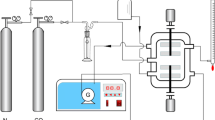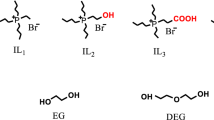Abstract
One of the challenges with regard to the aqueous amine-based CO2 capture process is the considerable energy requirement for solvent regeneration. To overcome this challenge, a biphasic solvent was employed in this study. Here, the phase separation behavior of amine blends depending on the characteristic structures of the solvent component was investigated using a turbidity measurement apparatus. Amines were classified as (1) primary/secondary amines or tertiary/sterically hindered amines depending on the CO2 reaction species, such as carbamate and bicarbonate (2) alkyl and alkanolamines, depending on the presence of a hydroxyl group, (3) chain and cyclic amines, and (4) mono- and polyamines depending on the molecular structure. Easy phase separation occurred in solvent blends containing polyamines such as DETA (diethylenetriamine), TETA (triethylenetetramine), and DEEA (2-(diethylamino) ethanol). The types with the greatest potential were the DETA/DEEA blended solvents. A phase separation could be determined based on the difference in the reaction rate with CO2 and the low solubility between the carbamate species of DETA and DEEA.
Similar content being viewed by others
References
S. Seo, L. D. Simoni, M. Ma, M. A. Desilva, Y. Huang, M. A. Stadtherr and J. F. Brennecke, Energy Fuels, 28, 5968 (2014).
S. Zheng, M. Tao, Q. Liu, L. Ning, Y. He and Y. Shi, Environ. Sci. Technol., 48, 8905 (2014).
M. Aleixo, M. Prigent, A. Gilbert, F. Porcheron, I. Mokbel, J. Jose and M. Jacquin, Energy Procedia, 4, 148 (2011).
L. Raynal, P. Alix, P.-A. Bouillon, A. Gomez, M. le F. de Nailly, M. Jacquin, J. Kittel, A. di Lella, P. Mougin and J. Trapy, Energy Procedia, 4, 779 (2011).
P. Bruder and H. F. Svendsen, Energy Procedia, 23, 45 (2012).
Z. Xu, S. Wang and C. Chen, Int. J. Greenh. Gas Control, 16, 107 (2013).
J. Zhang, Y. Qiao and D. W. Agar, Chem. Eng. Res. Des., 90, 743 (2012).
Q. Ye, X. Wang and Y. Lu, Int. J. Greenh. Gas Control, 39, 205 (2015).
M. Hasib-ur-Rahman, M. Siaj and F. Larachi, Int. J. Greenh. Gas Control, 6, 246 (2012).
M. Hasib-ur-Rahman and F. Larachi, Environ. Sci. Technol., 46, 11443 (2012).
Author information
Authors and Affiliations
Corresponding authors
Additional information
This paper is reported in the 11th China-Korea Clean Energy Workshop.
Rights and permissions
About this article
Cite this article
Lee, J., Hong, Y.K. & You, J.K. Phase separation characteristics in biphasic solvents based on mutually miscible amines for energy efficient CO2 capture. Korean J. Chem. Eng. 34, 1840–1845 (2017). https://doi.org/10.1007/s11814-017-0067-4
Received:
Accepted:
Published:
Issue Date:
DOI: https://doi.org/10.1007/s11814-017-0067-4




